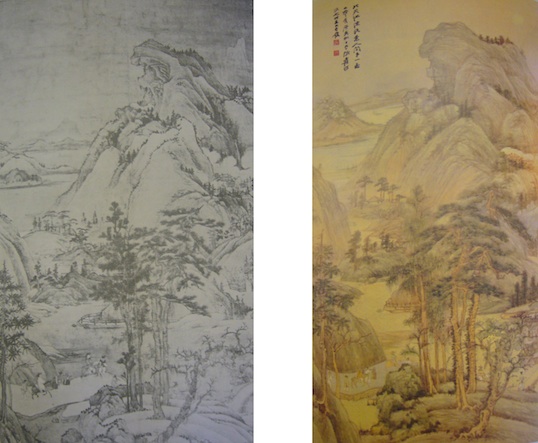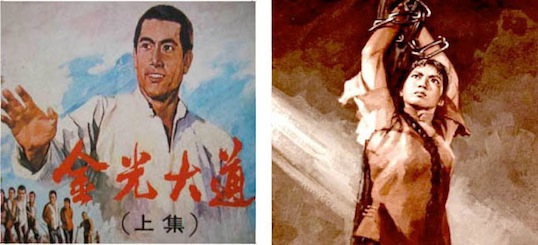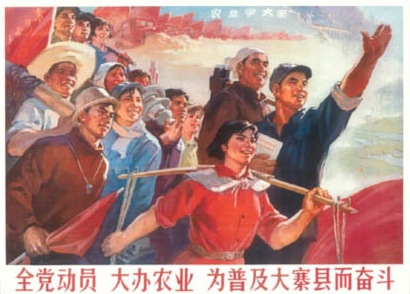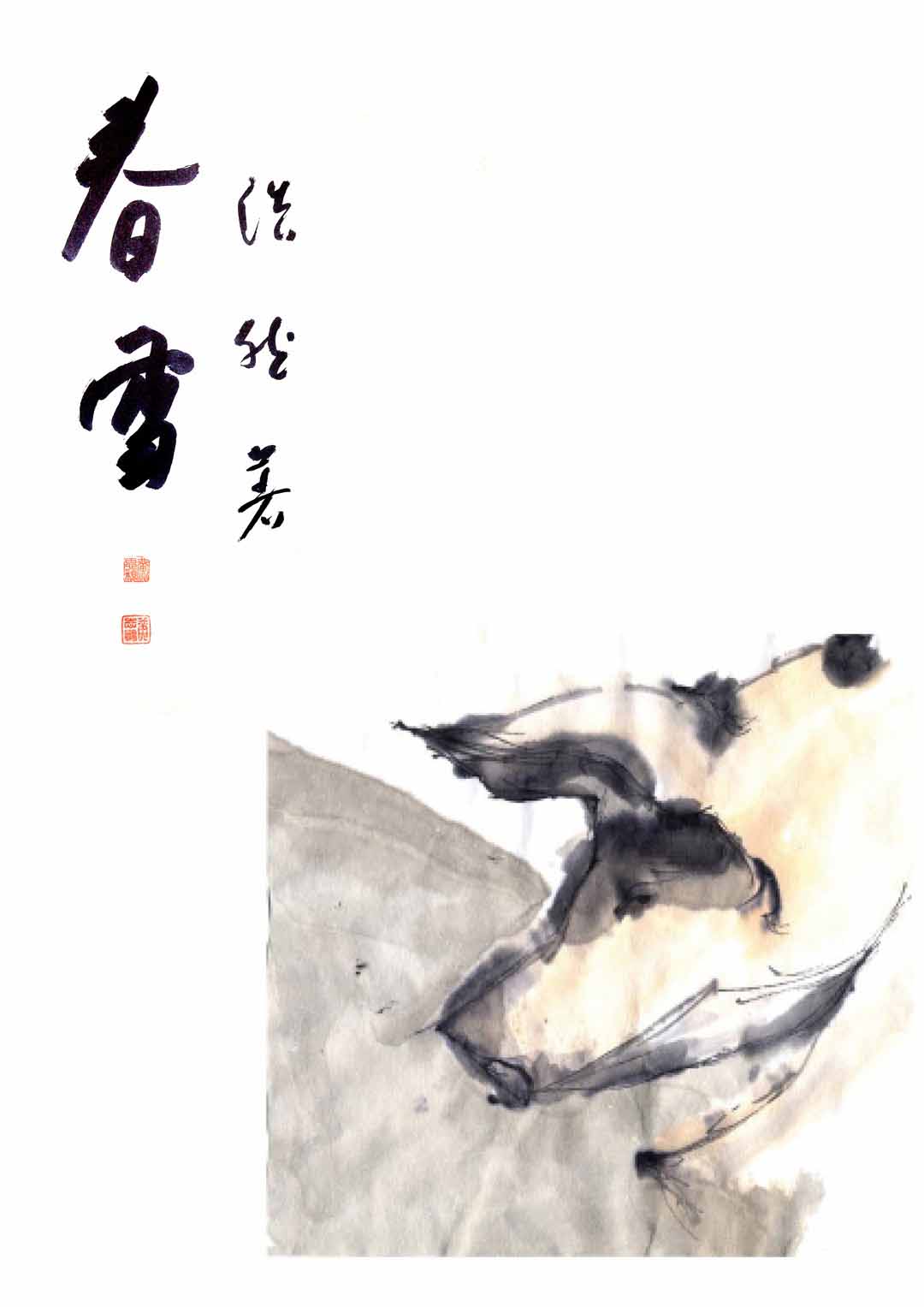by Judith Huang
"I don't care if it's a white cat or a black cat. If it catches mice, it is a good cat." – Deng Xiaoping
What is Guo Hua?
Translated literally, "Guo Hua" (国画) is "National Painting", or, more broadly, "National Art". Usually, it is used to refer to traditional Chinese painting, a venerable tradition handed down in the Confucian style, with a canon of manuals, old masters, techniques and traditions. However, the Cultural Revolution (1967-1976) marked a significant break in China's history and culture. During this period, many treasures, including priceless examples of Guo Hua or Shu Fa (traditional calligraphy), were systematically destroyed by roving bands of Red Guards in symbolic acts of destruction.
In its place, a new kind of "National Art" arose – Socialist Realism, best exemplified in the posters, films and memorabilia of the Cultural Revolution, which today has attained the status of collectible kitsch. The latest layer of irony is the use of Cultural Revolution artefacts in contemporary Chinese art and merchandise – marking yet another break in the art and ideology of China, now a hybrid sort of state-promoted capitalism.
Wang Xiaobo, in his essay "The Intellectual's Misfortune" (《知识分子的不幸》), had this to say about Guo Hua:
The most horrifying part was the word "Guo" ("National") appended to whatever we said. Append "Guo" to anything, and immediately it shuts down any discussion. It is a collar snapped around your neck, impossible to remove, and who knows how many years we have been wearing it.
(Trans. Judith Huang)
Imperial China versus Communism; Communism versus Capitalism – Deng Xiaoping's black and white cat, cultural control and the need for a unified national art – these ideas are presciently explored in "Chun Xue" (Spring Snow), a late Cultural Revolution short story by Hao Ran—the only writer to publish any fiction during the 10 years of the Cultural Revolution. Artistically, he is famous for a beautifully descriptive style, his observation of rural life, and his mastery of suspense. The usual scholarly assessment of his work is that it is propaganda of the most obvious kind. Indeed, most Mainland Chinese who lived through the Cultural Revolution would have read Hao Ran's work. His short stories, containing lyrical portraits of peasant life, focused on the nobility of peasants and workers who sacrificed their lives for the revolution.
The stories' meaning is usually obvious. However, this was not what I felt the first time I read "Chun Xue". As an overseas Chinese initially unfamiliar with Hao Ran's work, I actually thought it was a rich, intensely ambiguous piece of literature. The narrator, a minor party official, sets off on a lonely mountain road in spring. Halfway through his journey, the car is suddenly stopped and pretty much hijacked by a fierce peasant girl dressed in a red raincoat. Hao Ran's description is less than flattering:
The swarthy face beneath the raincoat hood was fixed with an anxious expression,
the two slit-like eyes shone with intense sincerity,
the pair of palms stopping the car were not big, but each finger was very thick...
(Plate 5, trans. Judith Huang and Huang Zhipeng)
She asks to be let off at a nearby village, all the while toting a very alarming-looking knife. The narrator develops his suspicions, particularly when, on the way to the village, she inexplicably yells expletives at a passing cyclist wearing yellow. The narrator decides to follow her when she gets off at a small village, just in case she is a bad element and needs to be reported to the police.
Once in the village, he hears rumours of an impending showdown between two people who are competing to castrate pigs. One is the girl, who is doing it for free, out of principle, for the people; the other is a genteel, scholarly older man, Doctor Huang, who does it for profit. Doctor Huang has faked sick leave from his regular job, sneaking off to perform this little sideline on the sly. He tries to cast doubt on the girl's ability to castrate pigs since she is an unschooled woman. Things come to a head when a customer is unable to pay the full fee for Doctor Huang's services. Speaking to the whole village, the girl curses at the doctor and loudly offers to do anyone's pigs for free.
Doctor Huang bitterly complains that the girl had undercut him in a different precinct the previous week, and that she was now following him around, stealing his business. He argues that he is just trying to make a little money on the side, that things are different now – people are free to make a little money. The girl retorts that he is a salaried official, on government time, and should be spending time helping the people rather than trying to earn money. She yells that, however free, people should not be free to cheat others! With the help of the villagers, the girl wins the marketplace showdown, running the shamed doctor out of town and threatening to crush him should he show his face again. The narrator, satisfied with this outcome, returns to his car and drives off, reflecting that Spring snow, while nourishing for useful elements such as the crops and flowers, is also able to kill off all manner of pests.
The story takes place towards the end of the Cultural Revolution, when small-scale capitalism, such as that demonstrated by Doctor Huang, was just starting to be tolerated, and Hao Ran's story clearly registers disapproval. The two main characters, the fierce girl dressed in Revolutionary red, and the decrepit (read decadent) scholar dressed in cowardly, imperial yellow are supposed to represent Communism and Capitalism, locked in an ideological showdown.
To borrow Deng Xiaoping's feline analogy, the cat in this story is either red or yellow. Presumably, the reader is supposed to conclude that we should prefer a red cat. However, the depiction of the girl is highly ambiguous. She is ugly, coarse, frightening, severe. And furthermore, the thing they are competing to do is castrating pigs! If the girl represents the CCP and Doctor Huang the "five undesirables" of the Cultural Revolution, then what do the pigs represent? The people? The country? Culture?
I asked a friend who grew up in China and was familiar with Hao Ran's work, but she thought the meaning of the text quite simple: the girl is right, and the man in yellow should be condemned. She said that she grew up reading many such formulaic stories, and all had the same meaning. She seemed not to feel the ambiguity I sensed, the ambiguity that I assumed was the point of the story. As a result, I decided to illustrate Spring Snow, to rescue the story from what I felt was the undeserved classification of propaganda, to bring out the ambiguity I was convinced was there.
In my illustrations, I sought to demonstrate the inherent conflict between the form and content of the story, drawing on the two traditions of "Guo Hua": Traditional Chinese Painting and the Socialist Realism of the Cultural Revolution.
As a Singaporean of Chinese descent, my relationship with Guo Hua is complex. My parents were Guo Hua enthusiasts. Growing up in the 80s, I tagged along with my parents to their Guo Hua teacher's place, taking the brush up and doodling a little; I also dabbled in calligraphy when I saw my aunt's brushes and got curious. From these rather humble beginnings (I never trained systematically in either art form) I absorbed just a little of the aesthetic as well as discipline of Traditional Chinese painting.
Quite naturally, I associate the "Nation" in "National Art" with China, even though I consider Singapore my country. Traditional Chinese painting is extremely formal and formulaic, and the process of learning it is very Confucian in character. For example, in bamboo grove-less, panda-less Singapore, a small girl is still required to copy the teacher's schematics to trace out bamboo leaves, to draw the pandas of her imagination. However, in the 80s, which was when I first learned Traditional Chinese painting, Guo Hua saw a spate of revivals and an explosion in experimentation. For example, Wu Guanzhong's post-Cultural Revolution, post-Deng paintings show the influence of Jackson Pollock and Picasso. His experimentation with colour and form marked a break in tradition with pre-Cultural Revolutionary Guo Hua.
I must hasten to add that although highly aware of the traditions of Guo Hua, I was not trained formally in them and my art training is almost entirely Western, though informed by an interest in traditional Chinese painting. Unlike me, Huang Zhipeng, a friend and colleague with a similar background as a Chinese Singaporean, is a highly trained artist, who has won many awards for his calligraphy. He was schooled in the rigorous tradition of the old masters through the Chinese calligraphy community in Singapore, achieving consistency and balance in his structured Kai Shu (Kai style calligraphy) and winning numerous competitions for his achievement in this field in Asia. He specializes in imitating Yan Zhenqing (颜真卿) (709-784), an old master of Chinese calligraphy.
Since I do not possess the necessary skills to imitate the rarefied traditional Guo Hua, nor the Socialist Realist credentials to produce Cultural Revolution-inspired posters, I decided to draw my influences from both kinds of "Guo Hua" spanning all the way to its modern incarnations. At one end of the spectrum of traditional Chinese painting, Plate 2, depicting the opening mountain scene, is a copy of Zhang Da Qian's (1899 - 1983) "Evening on the Lake" (《景晚提江》, in turn a copy of an old master, Tung Yuan's (c.934 - c.962 ) "Sunset on the Dyke").

At the other end of the spectrum, Plate 14 draws from Wu Guanzhong's abstract avant-garde paintings, with two specks - one red, one yellow - balanced before a house and tree. In this plate, I was trying to achieve a sense of the ideological battle depicted in the story, whereby the two ideologies, instead of being unequally matched like in Plate 13 (where the girl and the combined forces of the communist peasants overwhelm Doctor Huang) are in fact equally matched abstractions for our contemplation.
More playfully, drawing on Socialist Realism, Plate 6, the first portrait of the girl, deliberately subverts the venerable tradition of depicting beautiful women in Chinese painting. In order to express the highly masculine description of the girl, I actually drew on two poster images of a man and a woman demonstrating intense revolutionary fervour.

Although the portrait obviously resembles the Socialist Realist portraits more than the dreamy, ethereal fairies of traditional Chinese painting, the calligraphy, executed in a corner instead of splashed across the page like in a poster, abstracts the portrait from its Cultural Revolutionary context, suggesting a continuity as well as dissonance between Guo Hua depictions of women and Cultural Revolution depictions of a kind of militant feminism; a kind of fusion between expressionism and traditional Chinese painting, resembling the irreverent cartoons of persecuted intellectuals such as Huang Yongyu (of the famous "winking owl") of the Cultural Revolutionary era.
Calligrapher Zhipeng also decided to "let loose" on this project. It's a first for him, but he was very excited to try his hand at something more experimental, which he had been planning to do for some time. He says: "Traditionally, painting is accompanied by high poetry, the literary merits of which demand an aesthetically appropriate presentation. Extrapolating from this principle, more mundane topics should be presented in a mundane manner–which is my objective here. I also feel that it is important to use a style that is consistent with the Cultural Revolution background of the story, and hence I used only simplified characters with modern punctuation, avoiding the "high" calligraphy practice of traditional characters and no punctuation. Judith's modern Guo Hua-inspired painting style informed my calligraphy decisions, and simplified the process of determining the shape of the texts I would set (flat or tall rectangles)."
In completing the illustrations first and adding the calligraphy later, we also follow Guo Hua tradition, as well as, interestingly, Socialist Realism, which tends to append a text to any image it creates in order to ensure the correct interpretation. Zhipeng's calligraphy sets up additional dynamics between words and images, and between calligraphy style and the content of the text by both following and subverting the twin Guo Hua traditions – giving us an additional layer of irony.

Thus Zhipeng's calligraphy can also be read as a fusion of traditional Guo Hua and the new Guo Hua of the Cultural Revolution. In its focus on the mundane or plebeian, it is very much informed by the populist fervour of the Cultural Revolution. Yet, it never ceases to be playful and subversive. For example, in Plate 11, he uses a markedly different style for the speech by Doctor Huang, which resembles his usual formal style more, reflecting the highfalutin nature of the character as one of the educated intelligentsia. However, the words spewing from his mouth are anything but scholarly – they are the words of the marketplace, demanding that his customers not bargain with him. Throughout our collaborative project, this kind of interplay between image and text, and also the changing form of the text, emphasizes the ambiguity we found in Hao Ran's original story.
In a world where the cat is now neither red or yellow, but rather an awkward lurid orange, we feel that this project was an exploration into what it means to produce Chinese Guo Hua and Shu Fa today. It communicates the liveliness and ambiguity I read in Hao Ran's prose, essentially an elegiac piece on Communism, ending in a poetic and yet strained propagandistic note:
Indeed, to the apricot's red buds,
to the willow's fresh green shoots,
and to the wheat seedlings stretching their backs in the soil,
the spring snow is a wholesome, nourishing dew;
but to all manner of pests,
it carries the threat of extinction!
(Plate 14, trans. Judith Huang and Huang Zhipeng)

